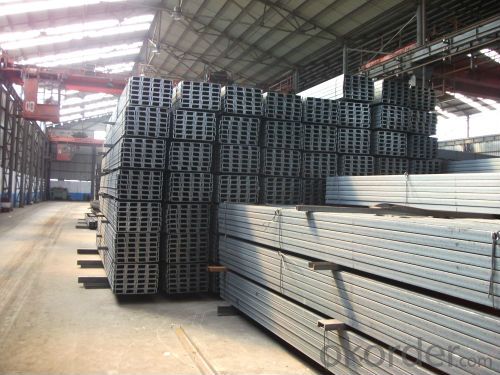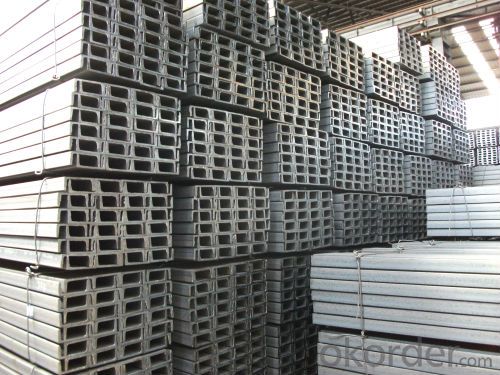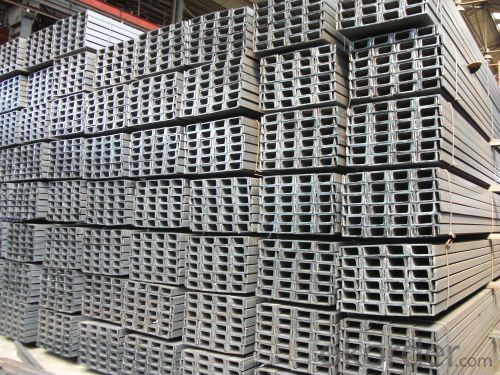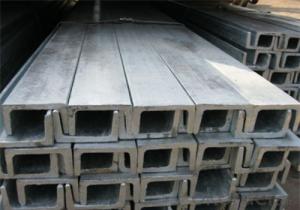U Channel Beam Channel Iron Sizes Steel
- Loading Port:
- Tianjin
- Payment Terms:
- TT or LC
- Min Order Qty:
- 28 m.t.
- Supply Capability:
- 40000 m.t./month
OKorder Service Pledge
OKorder Financial Service
You Might Also Like
Product Description:
OKorder is offering U Channel Beam Channel Iron Sizes Steel at great prices with worldwide shipping. Our supplier is a world-class manufacturer of steel, with our products utilized the world over. OKorder annually supplies products to European, North American and Asian markets. We provide quotations within 24 hours of receiving an inquiry and guarantee competitive prices.
Product Applications:
U Channel Beam Channel Iron Sizes Steel are ideal for structural applications and are widely used in the construction of buildings and bridges, and the manufacturing, petrochemical, and transportation industries.
Product Advantages:
OKorder's U Channel Beam Channel Iron Sizes Steel are durable, strong, and resist corrosion.
Main Product Features:
· Premium quality
· Prompt delivery & seaworthy packing (30 days after receiving deposit)
· Corrosion resistance
· Can be recycled and reused
· Mill test certification
· Professional Service
· Competitive pricing
Product Specifications:
channel iron sizes steel u channel beam
1.Specification: from 5# to 30#
2.Size 50*37 to 300*89
3.Material:Q235 SS400 Q345
| U CHANNEL BEAMS(JIS) | ||||
| MATERIAL:Q235/SS400/ST37-2 and Q345/ST52 | ||||
| Size | Size/mm | Theoretical Weight | ||
| h | b | d | kg/m | |
| 75*40*3.8 | 75 | 40 | 3.8 | 5.3 |
| 75*40*4.0 | 75 | 40 | 4 | 5.6 |
| 75*40*4.5 | 75 | 40 | 4.5 | 5.85 |
| 75*40*5.0 | 75 | 40 | 5 | 6.92 |
| 100*50*3.8 | 100 | 50 | 3.8 | 7.3 |
| 100*50*4.2 | 100 | 50 | 4.2 | 8.03 |
| 100*50*4.5 | 100 | 50 | 4.5 | 8.97 |
| 100*50*5 | 100 | 50 | 5 | 9.36 |
| 125*65*5.2 | 125 | 65 | 5.2 | 11.66 |
| 125*65*5.3 | 125 | 65 | 5.3 | 12.17 |
| 125*65*5.5 | 125 | 65 | 5.5 | 12.91 |
| 125*65*6 | 125 | 65 | 6 | 13.4 |
| 125*65*5.5 | 150 | 75 | 5.5 | 14.66 |
| 150*75*5.7 | 150 | 75 | 5.7 | 16.71 |
| 150*75*6 | 150 | 75 | 6 | 17.9 |
| 150*75*6.5 | 150 | 75 | 6.5 | 18.6 |
| U CHANNEL BEAMS(CHINESE STANDARD) | ||||
| MATERIAL:Q235/SS400/ST37-2 and Q345/ST52 | ||||
| Size | Size/mm | Theoretical Weight | ||
| h | b | d | kg/m | |
| 5 | 50 | 37 | 4.5 | 5.438 |
| 6.3 | 63 | 40 | 4.8 | 6.634 |
| 8 | 80 | 43 | 5 | 8.045 |
| 10 | 100 | 48 | 5.3 | 10.007 |
| 12.6 | 126 | 53 | 5.5 | 12.318 |
| 14a | 140 | 58 | 6 | 14.535 |
| 14b | 140 | 60 | 8 | 16.733 |
| 16a | 160 | 63 | 6.5 | 17.24 |
| 16 | 160 | 65 | 8.5 | 19.752 |
| 18a | 180 | 68 | 7 | 20.174 |
| 18 | 180 | 70 | 9 | 23 |
| 20a | 200 | 73 | 7 | 22.637 |
| 20 | 200 | 75 | 9 | 25.777 |
| 22a | 220 | 77 | 7 | 24.999 |
| 22 | 220 | 79 | 9 | 28.453 |
| 25a | 250 | 78 | 7 | 27.41 |
| 25b | 250 | 80 | 9 | 31.335 |
| 25c | 250 | 82 | 11 | 35.26 |
| 28a | 280 | 82 | 7.5 | 31.427 |
| 28b | 280 | 84 | 9.5 | 35.823 |
| 28c | 280 | 86 | 11.5 | 40.219 |
| 30a | 300 | 85 | 7.5 | 34.463 |
| 30b | 300 | 87 | 9.5 | 39.173 |
| 30c | 300 | 89 | 11.5 | 43.833 |
| 32a | 320 | 88 | 8 | 38.083 |
| 32b | 320 | 90 | 10 | 43.107 |
| 32c | 320 | 92 | 12 | 48.131 |
| 36a | 360 | 96 | 9 | 41.814 |
| 36b | 360 | 98 | 11 | 53.466 |
| 36c | 360 | 100 | 13 | 59.928 |
| 40a | 400 | 100 | 10.5 | 58.928 |
| 40b | 400 | 102 | 12.5 | 65.208 |
| 40c | 400 | 104 | 14.5 | 71.488 |
FAQ:
Q1: Why buy Materials & Equipment from OKorder.com?
A1: All products offered byOKorder.com are carefully selected from China's most reliable manufacturing enterprises. Through its ISO certifications, OKorder.com adheres to the highest standards and a commitment to supply chain safety and customer satisfaction.
Q2: How do we guarantee the quality of our products?
A2: We have established an advanced quality management system which conducts strict quality tests at every step, from raw materials to the final product. At the same time, we provide extensive follow-up service assurances as required.
Q3: How soon can we receive the product after purchase?
A3: Within three days of placing an order, we will begin production. The specific shipping date is dependent upon international and government factors, but is typically 7 to 10 workdays.



- Q:What are the different methods of anti-slip treatment for steel channels?
- There are several different methods of anti-slip treatment for steel channels, each offering their own advantages and suitability for specific applications. Some of the commonly used methods include: 1. Grip tape: This is a cost-effective solution that involves applying adhesive-backed tape with a textured surface onto the steel channel. Grip tape is easy to install and provides good traction, making it suitable for areas with light to moderate foot traffic. 2. Anti-slip coatings: These coatings are specially designed to create a rough surface on the steel channel, enhancing slip resistance. They can be applied using a brush, roller, or spray, and are available in various materials such as epoxy, polyurethane, or acrylic. Anti-slip coatings are durable and can withstand heavy foot traffic, making them suitable for industrial environments. 3. Perforated plates: These are steel plates with small holes punched throughout their surface, allowing water or other liquids to drain through and reducing the risk of slipping. Perforated plates are often used in outdoor areas or where liquids are present, such as walkways, platforms, or stair treads. 4. Expanded metal: This is a type of steel sheet that is slit and stretched to create a pattern of diamond-shaped openings. The raised surface of expanded metal provides excellent anti-slip properties, making it suitable for ramps, stair treads, or catwalks. Expanded metal is also durable and resistant to corrosion, enhancing its longevity. 5. Welded serrated grating: This method involves welding serrated bars onto a steel channel, creating a rugged surface that improves traction. Welded serrated grating is commonly used in heavy-duty applications, where high slip resistance is required, such as oil rigs, power plants, or manufacturing facilities. It's important to consider the specific requirements of the steel channel and the intended usage when selecting an anti-slip treatment method. Factors such as foot traffic, exposure to liquids, and the need for durability should be taken into account to ensure the chosen method is appropriate for the application.
- Q:What are the factors that affect the price of steel channels?
- There are several factors that can impact the price of steel channels. 1. Raw material costs: The price of steel channels is heavily influenced by the cost of raw materials, particularly steel. Fluctuations in the price of iron ore, coal, and other materials used in steel production can directly affect the cost of manufacturing steel channels. 2. Supply and demand: The overall demand for steel channels in the market can impact their price. If demand is high and supply is limited, prices are likely to increase. Conversely, if demand is low and there is excess supply, prices may decrease. 3. Manufacturing and processing costs: The cost of producing steel channels, including labor, energy, and equipment expenses, can impact the final price. Higher manufacturing costs may lead to higher prices for steel channels. 4. Market competition: The level of competition among steel channel manufacturers can also influence prices. When there are multiple producers offering similar products, they may engage in price competition to attract customers, resulting in lower prices. Conversely, if there are fewer suppliers or if they have a unique product, prices may be higher. 5. Transportation and logistics: The cost of transporting steel channels from manufacturing facilities to distribution centers or end-users can impact the final price. Factors such as fuel prices, shipping distances, and transportation infrastructure can all affect transportation costs, which may be passed on to the buyer. 6. Government regulations and tariffs: Trade policies, import duties, and government regulations can also affect the price of steel channels. Tariffs imposed on imported steel channels can increase their price, while government subsidies or support can lead to lower prices. 7. Economic conditions: Overall economic conditions, both globally and domestically, can have an impact on steel channel prices. Factors such as economic growth, inflation, and currency exchange rates can all influence the cost of steel channels. It is important to note that these factors are interrelated and can vary depending on the specific market dynamics and location. Therefore, understanding these factors and their potential impact is crucial for buyers and sellers in the steel channel industry.
- Q:Can steel channels be used for overhead garage doors?
- Indeed, overhead garage doors can utilize steel channels. These channels offer robust and long-lasting reinforcement for the garage door's weight. Frequently employed as vertical tracks, they serve to direct the door's movement during opening and closing. Renowned for their durability and ability to withstand bending or warping, steel channels present a dependable option for overhead garage doors. Moreover, they can be tailored to accommodate the precise measurements of the garage door, guaranteeing a suitable and secure installation.
- Q:Can steel channels be used for window frames?
- Yes, steel channels can be used for window frames. Steel channels provide excellent strength, durability, and resistance to corrosion, making them suitable for window frames that require stability and longevity.
- Q:Are steel channels suitable for sports facility construction?
- Yes, steel channels are suitable for sports facility construction. Steel channels are commonly used in construction due to their strength and durability. They provide structural support and are capable of withstanding heavy loads, making them ideal for sports facilities that require large open spaces and need to accommodate a large number of people. Steel channels can be used for the construction of grandstands, bleachers, and other seating areas, as well as for framing structures such as roofs and walls. Additionally, steel channels are resistant to corrosion, making them a reliable choice for sports facilities that may be exposed to outdoor elements. Their versatility and ability to be easily customized and fabricated to meet specific design requirements make steel channels a popular choice in sports facility construction.
- Q:What are the different types of support methods for steel channels?
- Depending on the application and structural needs, various support methods are available for steel channels. Some commonly used methods include: 1. Beam and column supports: Beams and columns can provide vertical support and distribute the weight of the steel channel. This method is frequently employed in building construction, where steel channels serve as structural components. 2. Hanging supports: Steel channels can be suspended using rods, cables, or chains. This method is suitable when the channel needs to be elevated or hung from a ceiling or overhead structure. 3. Bracket supports: Brackets fixed to a wall or other surface can offer lateral support and stability to steel channels, preventing bending or twisting under load. This method is popular in shelving systems or wall-mounted installations. 4. Channel supports: Steel channels can be supported by other channels, forming an interconnected support system. This approach is useful when multiple channels need to be joined to create a larger structure or framework. 5. Channel cleats: Channel cleats, metal brackets bolted or welded to the channel and then fixed to a supporting structure, can provide a secure and rigid connection. This method ensures a sturdy support for the channel. 6. Channel frames: Multiple channels can be connected to form a frame or structure, providing support for steel channels. This method is often used in applications like conveyor systems or equipment supports. In conclusion, the selection of a support method for steel channels should take into account factors such as the specific application, load requirements, and desired level of stability and rigidity. Professional engineers and designers should carefully consider these factors to choose the most suitable support method for their project.
- Q:How do steel channels contribute to the overall sustainability certifications of a project?
- Steel channels can contribute to the overall sustainability certifications of a project in several ways. Firstly, steel channels are often made from recycled steel, reducing the demand for new raw materials and minimizing the environmental impact of the production process. Additionally, steel channels have a long lifespan and are highly durable, which means they require less frequent replacement and maintenance, leading to reduced waste generation. Furthermore, steel channels can be easily recycled at the end of their life cycle, making them a sustainable choice. Overall, incorporating steel channels into a project can help achieve sustainability goals by reducing resource consumption, minimizing waste, and promoting circularity in the construction industry.
- Q:Can steel channels be used for conveyor systems?
- Certainly, conveyor systems can utilize steel channels. The utilization of steel channels in conveyor systems is widespread owing to their robustness, longevity, and adaptability. They furnish a solid framework for bolstering and directing the conveyor belt or other transported materials. Furthermore, steel channels can be effortlessly customized and incorporated into conveyor systems, thanks to their compatibility with diverse components and accessories like rollers, brackets, and supports. Moreover, steel channels exhibit resistance against wear, corrosion, and harm, thus rendering them suitable for demanding and rigorous applications.
- Q:How do steel channels perform under vibration?
- Steel channels generally perform well under vibration due to their high stiffness and strength properties. They have the ability to resist and dampen vibrations, making them suitable for various applications where stability and durability are required. The inherent rigidity of steel channels helps minimize unwanted movement and maintain structural integrity, ensuring reliable performance even in high-vibration environments.
- Q:What are the typical tolerances for steel channels?
- Steel channels can have varying tolerances depending on their specific application and industry requirements. Industry standards and specifications generally define the common tolerances for steel channels. Regarding dimensional tolerances, the width, depth, and thickness of steel channels typically fall within a range of ±0.005 to ±0.030 inches. These tolerances ensure that the steel channels meet the desired dimensions accurately, enabling them to be assembled or integrated into various structures or systems. For straightness, steel channels usually have a tolerance of 1/8 to 1/4 inch over a specified length. This ensures that the channels can be easily aligned and installed without significant deviations. Surface finish tolerances are also crucial for steel channels as they affect both appearance and functionality. Roughness measurements like Ra (average roughness) or Rz (mean roughness depth) define the typical tolerances for surface finish. Depending on the specific application requirements, these tolerances can range from 20 to 125 microinches for Ra and 100 to 600 microinches for Rz. It is essential to note that these tolerances serve as general guidelines, and the actual tolerances may differ based on the manufacturing process, industry standards, and customer specifications. Therefore, it is advisable to consult the relevant standards or communicate with the steel channel manufacturer to determine the specific tolerances required for a particular application.
1. Manufacturer Overview |
|
|---|---|
| Location | |
| Year Established | |
| Annual Output Value | |
| Main Markets | |
| Company Certifications | |
2. Manufacturer Certificates |
|
|---|---|
| a) Certification Name | |
| Range | |
| Reference | |
| Validity Period | |
3. Manufacturer Capability |
|
|---|---|
| a)Trade Capacity | |
| Nearest Port | |
| Export Percentage | |
| No.of Employees in Trade Department | |
| Language Spoken: | |
| b)Factory Information | |
| Factory Size: | |
| No. of Production Lines | |
| Contract Manufacturing | |
| Product Price Range | |
Send your message to us
U Channel Beam Channel Iron Sizes Steel
- Loading Port:
- Tianjin
- Payment Terms:
- TT or LC
- Min Order Qty:
- 28 m.t.
- Supply Capability:
- 40000 m.t./month
OKorder Service Pledge
OKorder Financial Service
Similar products
New products
Hot products
Hot Searches
Related keywords





























